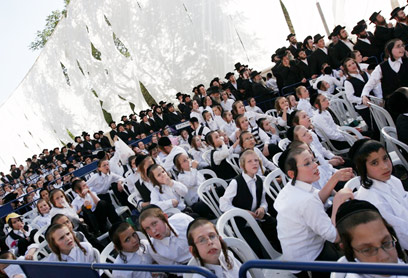JERUSALEM (VINnews) — An annual report by Israel’s Central Bureau of Statistics (CBS) shows that Israel’s chareidi population has risen to 1.28 million, or 13.5 percent of the reported 2022 total national population of 9.45 million.
Join our WhatsApp groupSubscribe to our Daily Roundup Email
Based on the 4% current growth rate within the chareidi community, the CBS projected that by 2030, it will constitute 16% of the total population.
Over 40% of those 1.28 million live in two cities, Jerusalem and Bnei Brak, outside Tel Aviv. Another 7% live in Beit Shemesh, and most of the rest live in predominantly chareidi towns and settlements like Modiin Illit, Beitar Illit and Elad, or in small enclaves in big cities like Ashdod, Petah Tikva, Haifa, Rehovot, and Netanya.
The analysis, compiled by the Israel Democracy Institute think tank, describes the community as poor, fast-growing, with exceedingly limited formal secular education, and with a strong sense of community and charity.
The data showed that the poverty rate among chareidim is twice as high as among the general population, with nearly half falling below the poverty line. However chareidim are using the internet much more than before the coronavirus pandemic.
“The upheaval created by the pandemic, which led to a dramatic increase in the number of chareidi internet users, remains unchanged, and two-thirds of the charedim today regularly use the internet. We see an increase in the proportion of working women and incomplete data for 2022 indicates an increase in the proportion of working men,” said Lee Cahaner and Gilad Malach, who edited the report.
The IDI analysis found that in 2019 — the last year for which data was available — the poverty rate among chareidi Israelis was 44 percent, while for the overall population it was 22 percent. This represents a slight improvement compared to previous years, when the charedi poverty was higher, with its peak in 2005, when the charedi rate was 58% and the overall rate was 21%.
In 2021, the employment rates among Haredi women are slightly lower but roughly the same as the non-charedi Jewish female population, 78% compared to 82%. At the same time, the unemployment rate among Haredi men is three times that of their non-charedi Jewish counterparts in 2021: 49% compared to 14%.
According to IDI, initial statistics from 2022 indicate a slight decrease in charedi male unemployment to 46.5%, though that is still roughly three times higher than non-charedi Jewish men.
The incoming government has proposed a broad range of measures to benefit the Haredi population, including increasing stipends for seminary students, which may disincentivize Haredi men from entering the workforce.
The average monthly salaries of charedi households — NIS 14,121 ($4,003) — were far lower than their non-charedi counterparts, who earned NIS 21,843 ($6,191).
Despite being far poorer, Haredi Israelis are significantly more likely to give money to charity and to volunteer than other Jewish Israelis, according to CBS data.
A CBS survey found that in 2021, 86% of charedi Israelis over the age of 20 said they’d donated to charity, compared to 58% of non-charedi Jewish Israelis. This has largely held steady for Haredi Israelis, as the number of non-charedi Israelis saying they donated to charity has dropped over the years, from 72% in 2008 to its current level.
Charedi Israelis were also nearly twice as likely to say they volunteered in their community, with 40% of charedim saying they’d done so, compared to 23% of non-charedi Jewish Israelis.
Due to high birthrates, charedi children represent nearly 20% of all students and more than a quarter of all Hebrew-speaking students.
The majority — 74% — study in “unofficial but recognized” schools, which are meant to follow the majority of the secular core curriculum (though most do not) in exchange for 75% funding, another 22.5% study in “exempt” schools that teach a smaller portion of the core curriculum and receive a commensurate amount of state funding, while just 3.5% learn in fully state-run charedi schools that teach the full core curriculum.
Charedi girls are increasingly being taught the state core curriculum — as they are being directed more to the workforce — with nearly 60% taking state matriculation exams in 2019/2020, almost double the number who did so in 2008-2009, according to IDI.
Boys, however, were far less likely to take — let alone pass — the state matriculation exams, and there was almost no change in the past 13 years, with 15% taking the tests in 2019-2020, compared to 16% in 2008-2009 and only 14% passing the examinations compared to 83% of non-chareidi students.
The number of Haredi students in institutions of higher learning remains disproportionately low, constituting 10.5% of all students in Israel, though it has risen dramatically in the past 13 years. More than 90% of these students attend colleges, which generally have lower entrance requirements than universities, according to IDI data.
Between 2014-2021, the IDI found, the number of men studying in yeshivas and kollels (full-time Talmudic study institutions) grew by 46%, to a total of 138,367 students.


This supposition posits that all the Chareidim will remain in Israel, and that all of them will remain in the community they were born into. Is this what has happened in the past, and what is happening now?
Soon enough yeshivas will double their funding while the tumadik and unnecessary IDF will be slashed as us maminim know it is Torah and not herzl, ben gurion or lapid who protects us